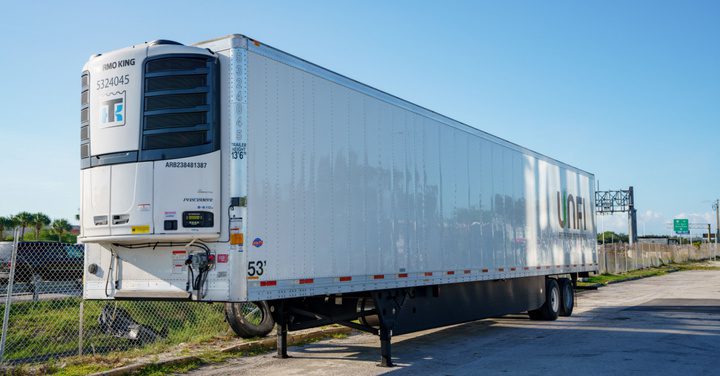Booking freight hasn’t been so advantageous for shippers in over two years. In March 2023, the refrigerated (reefer) trucking rates fell to a two-and-a-half-year low, egged on by changes in weather, volume demand, and improvements in fuel costs and optimization. The weak demand for freight further lowered costs while the difference between spot and contract rates were at historic highs, with differences of 59 cents per mile for vans, 57 cents for reefers, and 66 cents for flatbed freight. On top of this, concerns about a country-wide economic downturn remain — tighter lending standards from banks, combined with the interest rate increase from the Federal Reserve, slow spending and consumer demand — furthering lowering shipping demand.
This is the environment where shippers are currently booking volume. Since the conditions are so favorable, it’s the perfect time to reevaluate your processes and ensure you have reliable, scalable means of accessing affordable reefer capacity. Not sure where to start? Turn to experts like Logistics Group International to help your business get the best quote for your reefer shipments.
Five Strategies to Get the Best Quote for Your Reefer Freight
With a network of over 15,000 carriers that are positioned strategically across the United States, LGI is the expert at securing affordable, reliable refrigerated freight for all needs. They know that the secret to booking efficient, effective transport can be broken down into five easy steps: double-check the details, understand market rates, use a reputable carrier, optimize shipment size and frequency, and leverage technology solutions.
Strategy #1: Be Diligent with Details
Freight rates are generated based on information about the shipment, including weight, dimensions, shipment type, temperature, and any special considerations. It may seem like a no-brainer, but ensuring that all shipment details are correct is a first — and vital — step in receiving a reasonable quote.
A mismeasurement or omitted details — such as the spoilage date or temperature controls — can cause delays and additional costs. If the information provided about the shipment is incorrect or something is missing from the quote, you could be overpaying for your shipment or at risk of getting charged for last-minute changes. Ensure that the carrier gets all the correct information and details to transport your freight safely and efficiently.
Strategy #2: Understand Market Rates
Like many other things, market rates are determined by supply and demand. That’s lucky for you because that means that by keeping your finger on the pulse of the current market movements, you can ensure that you’re not overpaying for services. It also means you can use the going rate to negotiate better pricing when you feel a shipper is asking for above the market rate.
Understanding the market can also help you make strategic decisions about your shipping needs to optimize costs and improve profitability. Learning more about how market rates are determined and what you can do to keep up with changes can help your business save money in the short and long term. A good 3PL partner like LGI can help you stay current on market movements and get the latest details.
Strategy #3: Choose Reputable Carriers
We get it; it’s tempting to choose the lowest-cost carrier. But often, that initial discount comes with hidden costs later on. Using a carrier with an unknown or poor reputation can cause delays and incur additional hidden charges.
Reputable carriers have the expertise, equipment, and processes in place to transport reefer freight safely and efficiently. By partnering with reputable carriers, shippers can minimize risks and ensure their cargo is transported on time and in good condition. All this adds up to total cost savings and improved customer satisfaction.
Strategy #4: Optimize Shipment Size and Frequency
Another thing shippers can do to reduce costs and improve efficiency is to optimize shipment size and frequency. Shippers can negotiate better rates with carriers and minimize transportation costs by consolidating shipments and reducing the number of total shipments sent. This can also improve efficiency and reduce the environmental impact of shipping.
Strategy #5: Leverage Robust Technology
There are countless new and powerful technological tools available to shippers today. Technology helps shippers and carriers find routes and pricing and optimize loads. Data analytics and artificial intelligence (AI) increase capabilities and integrate more accurate forecasting, route optimization, and streamlined inventory management. Digital platforms make it possible for carriers and shippers to collaborate. They foster trust and build long-term partnerships based on transparency.
LGI’s dynamic freight pricing tool offers real-time pricing and capacity information from a network of carriers, allowing shippers to compare real-time trucking spot market rates and choose the best option for their needs. This can save time and reduce costs for shippers.
Streamline Reefer Shipments with Smart Technology and Smarter Partnerships
With the market favorable to shippers, it’s the ideal time to build partnerships and processes that will help ensure good prices and great service even when the winds change, as they inevitably will.
LGI is the partner you can count on to help your business access favorable rates, optimize shipping routes and costs, and increase visibility across the supply chain. Work with LGI to find the best routes, consolidate cargo efficiently, and better monitor your shipments along their route. Get in touch to request a free quote from LGI today.
